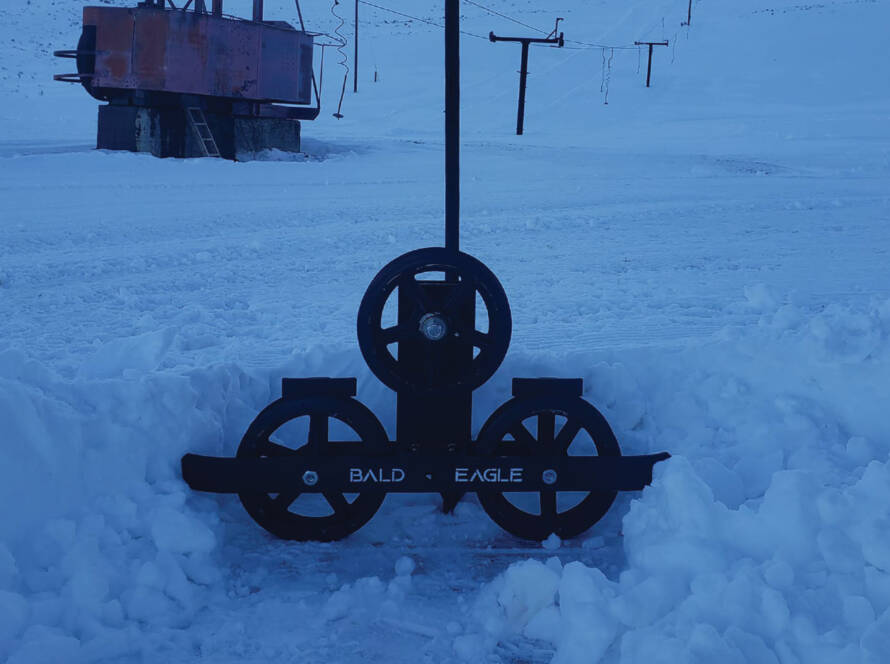Indeed, wooden telephone poles have been the standard for carrying above ground electrical services and communications since the telegraph was introduced in 1840. Wooden telephone poles seemed destined to continue as the above-ground standard for stringing up wires in Puerto Rico until Hurricane Maria devastated the island in 2017 with winds gusting in excess of 200 miles per hour, snapping almost all wooden utility poles like twigs.
As efforts to rebuild electrical and communications infrastructure got underway, engineers began asking, “Is it wise to use wooden telephone poles any longer?” The apparent vulnerability to wind raised serious cost-benefit issues on an island that is likely to experience many more unsettling weather events.
Mountain environments regularly experience high winds and other conditions that can impinge on above ground electrical and communications infrastructure. This is why the preferred option is underground conduit.
Yet, certain applications like slope lighting and snowmaking require poles and the choices have been between traditional wooden telephone poles and metal. Mountain operations managers understand that the trade-off is between cost and quality. Wood is less expensive and usually easier to install because it is “direct bury,” meaning it does not require a reinforced foundation such as a concrete casing. Steel and aluminum are more expensive, but offer longevity and greater durability. Metal often looks nicer, too.
In the aftermath of Hurricane Maria, new composite poles have been designed that are more durable than both wood and metal, are not subject to corrosion or rotting, and do not actively conduct electricity and are flexible with combined tensile strength to withstand substantial weight and wind loads. Although modestly more expensive than wood, composite poles are significantly less expensive than steel while having the added advantage of a “direct bury” mounting option.
The direct bury method utilizes ground depth as the support mechanism rather than pouring cement to create a concrete casing with anchor bolts. Direct bury can even work on rock ledges using drilling equipment and a sand filler. Another installation option uses helical piles and a ground-level mounting plate. Now, mountain operations managers have three choices for light poles and other above-ground mounting structures: wood, metal or plastic.
Sustainability
Climate change will have a real and immediate impact on local weather: winds will be stronger, snow events larger, rain storms more concentrated and avalanches more prevalent for high elevation resorts. Thus, when sustainability is a goal, the initial installation cost must be measured against durability, flexibility and the specific environment. For a modest additional expense, ski areas can gain easy and fast installation, longevity, low-to-no maintenance and movable infrastructure. This is not to say wood or metal should be ruled out if the cost-benefit analysis favors these materials over composite.
Consider the ability to easily and rapidly move mountain infrastructure. Ski resorts and areas on US Forest Service, U.S. National Park Service or other public lands are obligated to leave the property as it was found. That means chairlift towers, light poles and even slopes would need to be remediated if the land lease or use was ever abandoned. Direct bury poles are more easily removed than excavating or blasting out concrete casings. If helical piles are used, they can simply be unscrewed from the soil or rock. This may not seem like a present-day concern, but the entire concept of sustainability is about the future.
With regard to sustainability, new composite materials are generally recyclable. Hopefully, this is not a concern for a long time after installation, but it is a consideration. Wooden utility poles are treated with preservatives such as creosotes that cannot be disposed of easily in landfills or other disposal sites. Steel and aluminum are recyclable, but concrete piles must be removed and disposed of. Composite will not rust or react with the atmosphere, and it is impervious to insects. It is UV resistant and has greater flexibility than wood or metal. There is no concern about compatibility with the fixture that is mounted.
A consideration for off-slope lighting such as parking lots and access roads is the “breakaway” feature for some composite designs. A major cause of serious roadway injury and death is impact with poles that offer too much resistance to a moving vehicle. Composite material allows for various special designs including a shearing zone that can withstand normal flex, but will break away from a concentrated impact point. Responsible modern design should take such features into consideration.
On-slope lighting
Depending on slope dimensions, poles may need to accommodate one or multiple fixtures with various pointing angles. There are two standard mounting systems for most lighting: 1) U-bracket and 2) slip-fitter bracket. U-brackets do not offer the same range of motion, but easily attach to the typical angle brackets commonly used on wooden utility poles and older metal poles. U-brackets are not as strong as slip-fitters but are usually standard with the fixture or relatively less expensive than slip-fitters that require additional mounting hardware called “bullhorns.”
Slip-fitters or “pipe mounts” fit on top of a 2 3/8-inch pipe and are secured with compression locking screws. This allows 360 degrees of lateral rotation in addition to 90 degrees of vertical pivot. Slip-fitters are more commonly used for flood lighting applications because of the greater pointing range.
Bullhorns come in many configurations. They can be made in-house by bending and configuring 2 3/8-inch pipe, or purchased from a supplier. Make sure the spread between mounts is sufficient to accommodate the fixture’s dimensions. Depending on the lamp intensity and the focal length, one to four fixtures can be mounted on a cross-arm or bullhorn. There are also directional bullhorn mounts which can achieve a 360-degree illumination pattern. Composite poles can be configured with a single “cap” mount at the top that can receive a bullhorn or “T-Bar” – not to be confused with a T-bar lift. Using a T at the top accommodates U-bracket mountings.
Keep in mind that bullhorn mounts can be attached to most chairlift towers, eliminating independent light poles for some areas. When mounting lights to towers, make sure the fixtures are capable of handling vibration. Bulbs that have filaments can be damaged by excessive shaking or vibration. Mounting hardware is also susceptible to metal fatigue if there is too much vibration.
In most cases, it is unlikely a snow sports venue will require the design solution for Hurricane Maria. However, it is helpful to know that composite utility poles offer a high-integrity, cost-effective alternative to wood and metal. If new lighting infrastructure is in upcoming plans, composite poles may be the ultimate way to go.


![[image placeholder]](https://www.snowopsmag.com/wp-content/uploads/2023/09/placeholder@2x-890x664.png)
